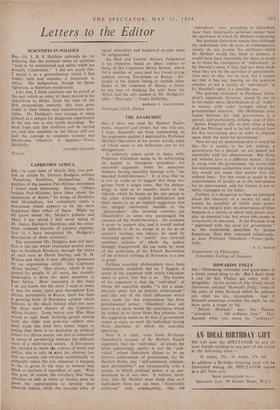CAPRICORN AFRICA SIR,—In your issue of March 26th, you pub-
lish an article by Thomas Hodgkin entitled' 'Panafrica, Eurafrica, Malanaf rice.' His analysis of the nascent Pan-African movement I found most interesting. Saying, " Others besides Pan-Africans, have ideas about the unification of Africa," he writes of Eurafrica and Malanafrica, but completely omits a movement which appears to be far more important than either of these. While we all know about Mr_ Malan's policies and ideas, I am afraid had never heard of M. Anton Zischka's Eurafrica and his some- what outdated theories of colonial exploita- tion (if I have interpreted Mr. Hodgkin's description of them correctly).
The movement Mr, Hodgkin does not men- tion is the one which originated several years ago in Southern Rhodesia through the vision of such men as David Sterling and N. H. Wilson and which is now officially sponsored by an organisation called The Capricorn Africa Society.' This society, which is sup- ported by people of all races, has recently undertaken a drive for more members in East Africa. How successful it has been I do not know, but the point I want to make is that for many years past throughout East Africa, particularly in Kenya, there has been a growing body of European opinion which believes in the ideals behind what are now the three main objects of the Capricorn Africa Society. Long before ever Mau Mau raised its ugly head, thinking people among both the older and post-war settlers who have made this land their home, began to realise that there is no economic or political future for Africa except one that is conceived in terms of partnership between the different races of a multi-racial society. If Europeans are inclined to stress the criteria of merit and ability, this is only to state the obvious fact that no society can advance economically or culturally unless the job, whatever it happens to be, is given to the man or woman best fitted to perform it regardless of race. With this goes, of course, the corollary that black Africans as well as white or brown, must be given the opportunities • to develop their inherent talents, while the interests alike of
racial minorities and backward peoples must be safeguarded.
An East and Central African Federation is an objective, based on ideals similar to those of the Capricorn Africa Society, which for a number of years past has found strong support among Europeans - in Kenya. En- larged in the distant future to include other States of the continent of Africa, it forms to my way of thinking the only hope for Africa and the only answer to Mr. Hodgkin's other " Pan-isms."—Yours faithfully,


































 Previous page
Previous page